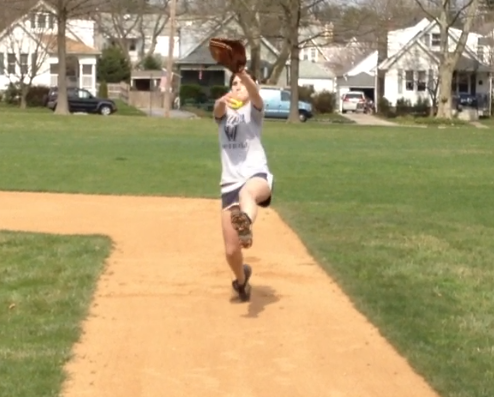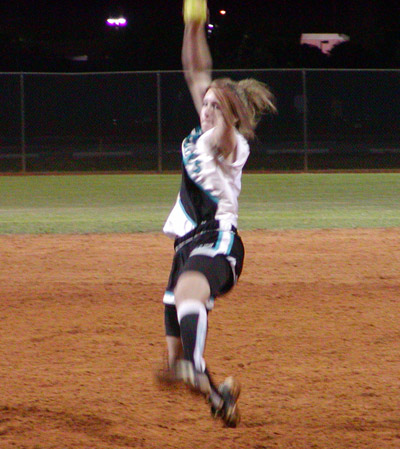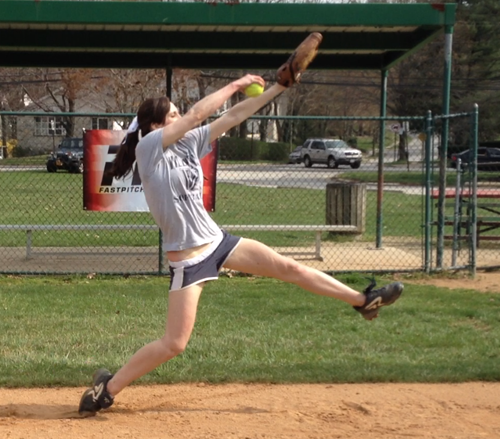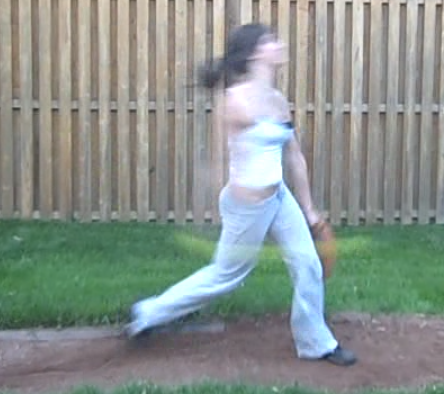Introduction to Pitching Terms
We’re thrilled that you’ve decided to learn windmill pitching or improve your pitching skills with us. Before you can fully take advantage of all the information Fastpitch Power has to offer, you need to understand what we’re talking about. In this introductory post, I will explain our most often used pitching terms, with a few pictures for reference. Let’s get started!
Power line
The power line is an imaginary straight line on the ground that starts in the middle of the pitching rubber and ends right below the catcher’s glove. If you’re just learning to pitch, you may want to draw a power line in the dirt or mark it with tape if you’re pitching indoors. To simplify the windmill pitch, if your pitching hand starts on the power line, never leaves the power line, and finishes on the power line, your ball will head right down the power line.
Load
The load is the first essential part of the windmill pitch, and the foundation for everything that comes after it. “Loading” means preparing your body to push off the pitching rubber as hard as possible. It’s called loading because you are essentially loading 100% of your body weight onto your push foot (that’s the right foot for righties, left foot for lefties), and getting ready to unload it like a catapult.
Sometimes people confuse the load with the pre-motion. They are not the same thing. The pre-motion is everything that happens before you push off the rubber, and everyone’s pre-motion is different. Some people bend forward, some people swing their arms back, etc. The load takes place during the pre-motion. However, pitchers often incorporate so much excess movement into their pre-motions that they actually miss the load. We’ll explore optimal pre-motions in a later post.
Reach
The reach is the next essential pitch component after the load. You may think that right after you push off the rubber, your pitching hand goes right into the arm circle. This is partially true, but what happens to your glove hand and your stride foot? If you’re pitching correctly, there will be a split second when all three of those things—your pitching hand, glove hand, and stride foot—are lined up and pointing directly at your catcher’s target. This is the reach, and it takes place when your hands, coming up the front side of the arm circle, are about at the level of your nose. The reach ensures that you’re starting the pitch in line with the strike zone. If you’re not, it’s very difficult to find the strike zone again once your body is moving 50-60 miles per hour.
The reach looks like this. We’ve put our pitcher in the lane down the first base line so you can really see how lined up everything is:
Track
You’ll hear us talk about torso tracking a lot. During the reach, you are still facing the catcher 100%. Immediately after that, you turn your body so that the side of your torso (on your glove-hand side) is pointed toward the catcher. This is called torso tracking. The purpose of the track is to create a clear path (we call this the “throw zone” or the “runway.” See below) for your arm, which started off pointing at the strike zone, to continue on down the throw zone and through the strike zone without taking any detours.
This is what the track looks like:
Notice the similarities and differences compared to the reach. The stride leg and the glove hand are still lined up with the catcher, but the torso has opened to the side.
Stride
The stride takes place over the course of the reach and the track. You extend your stride foot (left foot for righties, right foot for lefties) forward toward the catcher as your push foot pushes as hard as it can.
Drive through
What happens to your push leg when it’s done pushing? It becomes the drive through leg. As your arm comes over the top of the circle and begins descending to throw the ball, your drive-leg knee powers forward while the toe grazes the ground.
This is what the beginning of an effective drive through looks like. The knee is pointing forward, only the toe is in contact with the ground, and the foot isn’t “stuck in the ground;” momentum brings it forward even before the landing.
Fire
Sometimes you’ll hear us refer to forearm fire, and sometimes we’ll just say “fire!” This is the part where you let go of the ball. It sounds much fiercer than “release” or “snap,” don’t you think? Our forearm fire has very specific mechanics, which we will explore in depth in its own post.
Wrist snap
The wrist snap is a tiny but extremely important part of the pitch. It’s what your hand is doing at the time the ball is released; basically, it starts off loosely flexed and flops forward at the wrist. If you’re doing forearm fire correctly, the wrist snap takes place automatically. However, if you’re just learning to pitch, or if you’re having trouble with forearm fire, it will help to practice the wrist snap separately to get a good feel for it.
Throw zone
Sometimes also referred to as “the runway,” the throw zone is the straight path your hand takes at the bottom of the arm circle to fire the ball. It’s lined up perfectly with the power line. Most problems with control can be addressed by examining the integrity of the throw zone after each pitch; in the case of most bad misses and wild pitches, the throw zone was either blocked or moved.
This picture is a bit blurry, but as a result, it’s a great illustration of the path of the throw zone. Look at the streak left by the yellow ball:
Rotation
If we had to make a top 10 list of things we say to our students most frequently, “you’re rotating” would be near the top. When we refer to rotation in a pitch, we’re usually talking about the breakdown of the track, and, as a result, the throw zone. Once you track, you should maintain your track until the ball has left your hand. One of the most common issues windmill pitchers have is beginning to rotate back toward facing the catcher before releasing the ball. This causes the body to block the throw zone, taking away the arm’s clear path to the catcher’s target. This is such a common problem because it stems from a lack of core strength, which plagues the thousands of windmill pitchers who don’t train properly to prepare their bodies to pitch.
Please feel free to leave additional questions in the comments! If you’re curious about a term that we did not include in the list, we’d be happy to add it.



